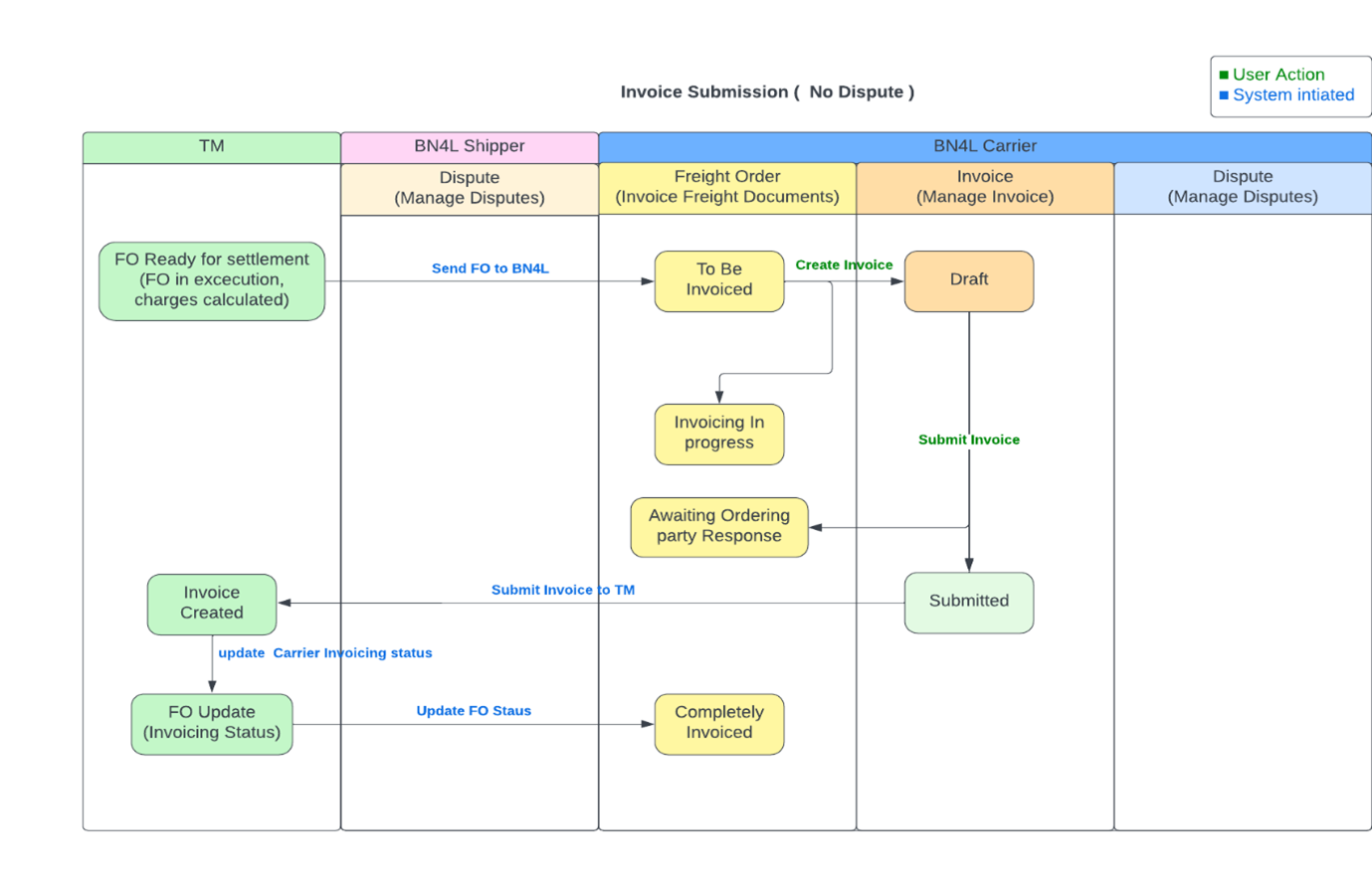
The Business Network for Logistics (BN4L) Freight Collaboration settlement process involves v 2024-1-4 16:44:17 Author: blogs.sap.com(查看原文) 阅读量:17 收藏
The Business Network for Logistics (BN4L) Freight Collaboration settlement process involves various apps. Each of these apps have their own statuses and actions that the user can perform. It can get quite overwhelming to understand the meaning of these statuses and the action that the user needs to take.
Below we go through some of the common scenarios and try to understand the document status and the action that is required to procced.
For all the scenarios, we will consider the shipper will resolve the dispute in BN4L (default option).
Scenario 1: No dispute.
In this scenario we will assume that a carrier is submitting an Invoice without any disputes.

Once the Freight Order is sent to the carrier, a new document is created within the “Invoice Freight Document” app, marked with the status “To Be Invoiced.” Subsequently, the carrier user can generate an invoice for this document by utilizing the “Create Invoice” button within the app. This action triggers the creation of an invoice document in the “Manage Invoice” app, labelled with the status “Draft,” concurrently adjusting the Freight Order status to “Invoicing in Progress.” As the carrier submits the invoice, the document status transforms to “Submitted,” while the Freight Order status evolves to “Awaiting Ordering Party Response.”
At this juncture, the system initiates the transmission of the invoice to the Transportation Management (TM) system. Upon successful creation of the invoice in TM, the carrier invoicing status undergoes an update within the Freight Order, subsequently relayed to BN4L. This transition culminates in setting the Freight Order status to “Completely Invoiced,” marking the successful completion of the invoicing process.
Scenario 2: Shipper accepts the dispute.
For this scenario we will assume that the carrier submits an invoice with some deviations. This will create a dispute which the shipper accepts.

Like the preceding scenario, the process follows a consistent path until the carrier initiates the submission of the invoice. Upon clicking “Submit,” the invoice document transitions to the status “Submitted,” concurrently setting the Freight Order (FO) status to “Awaiting Ordering Party Response.” Simultaneously, a dispute document is generated in the BN4L “Manage Disputes” app for the shipper, marked with the status “For Review.”
The shipper now reviews the disputes and opts to accept them. The dispute status advances to “Submitted for Confirmation,” triggering the dispatch of updated charges to the Transportation Management (TM) system to update the Freight Order. Upon TM’s acknowledgment of the changes, a confirmation message is sent back to BN4L, marking the dispute status as “Resolved.” The system proceeds to update the invoice, which is then transmitted to TM. Once the invoice is successfully created in TM, the Carrier Invoicing status is updated in the FO, and the corresponding information is conveyed back to BN4L, culminating in the adjustment of the FO status to “Completely Invoiced.”
Scenario 3: Shipper rejects the dispute.
For this we will assume the carrier submits the invoice with some deviation which creates a dispute. The shipper rejects the dispute, and the carrier accepts this. Then the carrier submits the revised invoice.

In this third scenario, mirroring the previous sequences, the carrier initially receives the Freight Order (FO), proceeds to create an invoice, introduces modifications, and subsequently submits it to the shipper. The invoice undergoes a transition to the “Submitted” status, concurrently adjusting the FO status to “Awaiting Ordering Party Response.” Simultaneously, a dispute document is initiated in the BN4L “Manage Disputes” app for the shipper. Upon the shipper’s review, a decision is made to reject the disputes, marking the dispute status as “Reviewed” and generating a dispute in the “Manage Disputes” app for the carrier, flagged with the status “To Be Approved.” Additionally, this action prompts a change in the invoice status to “In Dispute.”
The carrier now can peruse the shipper’s response and opt to negotiate or accept the rejection. Upon the carrier’s acceptance of the changes, the dispute progresses to the status “Submitted for Confirmation.” Consistent with prior scenarios, the Transportation Management (TM) Freight Order (FO) undergoes updates with modified charges. Upon receiving confirmation, both the shipper and carrier disputes transition to the status “Resolved,” and the system updates the invoice status to “Ready for Submission.”
At this stage, the carrier reviews the revised invoice and submits it to the shipper, triggering the invoice status to “Submitted” and initiating the transmission of the invoice to the TM system. Subsequently, the familiar process unfolds, updating the carrier invoicing status in the TM Freight Order, with the corresponding information sent to BN4L, ultimately adjusting the FO status to “Completely Invoiced.”
Final Remarks
There are multiple variations of the above flows but more or less it would flow in a similar way.
The BN4L settlement process also supports the handling of disputes by the shipper in their TM system. In this case the shipper dispute document is created in TM and the flow differs a little bit. We can look into that flow in future. The process for the carrier though remains the same as described above.
如有侵权请联系:admin#unsafe.sh